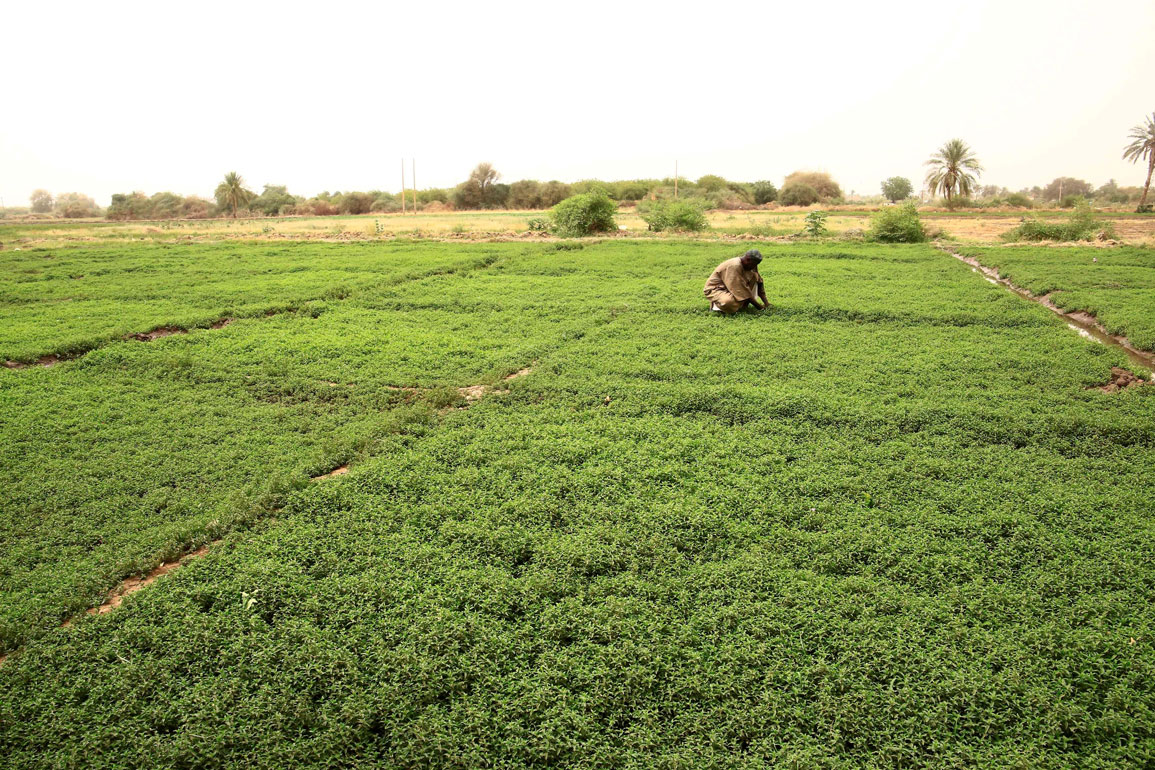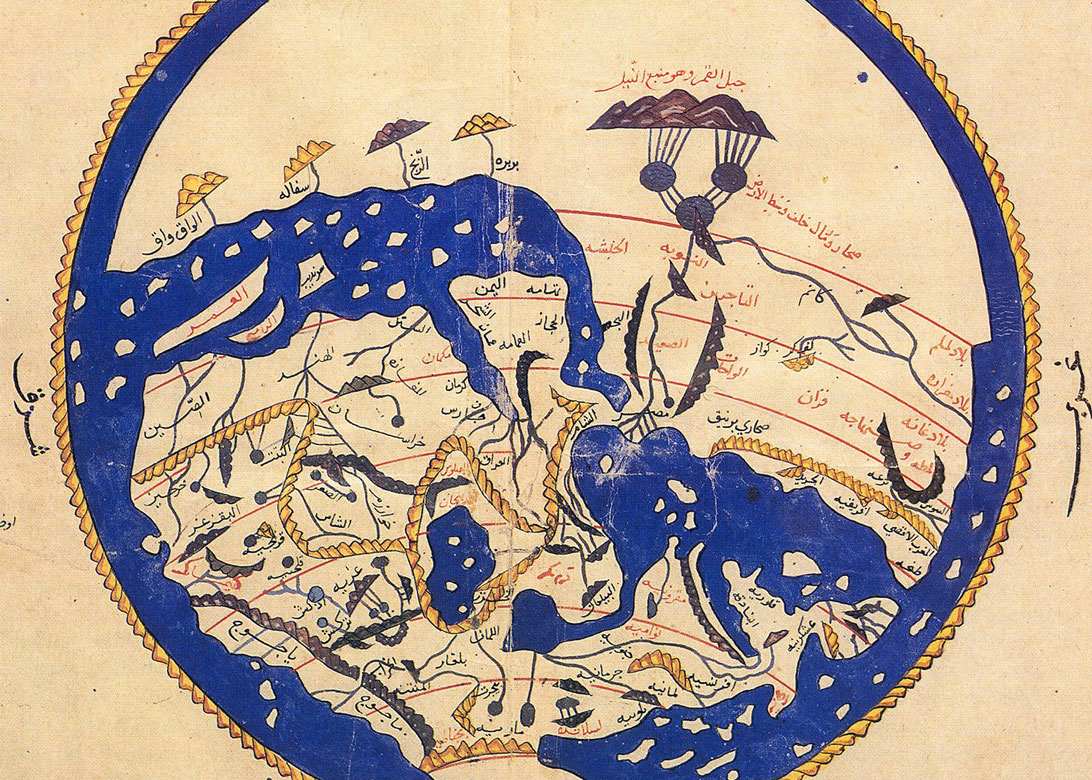How the colonial powers’ pressure to wean babies and boost the food economy hid a faulty argument on famine and malnutrition
A farmer works in his farm in Khartoum, Sudan, May 22, 2022 /
Mohamed Khidir / Xinhua via Getty Images
Afew years following the Universal Declaration of Human Rights, when the Gold Coast was gaining independence from Britain in the early 1950s, the British colonial government released a cookbook called “Gold Coast Nutrition and Cookery.” Maintaining a soft policy of influencing Ghana’s food culture, the 347-page book detailed a wealth of recipes.
Apart from the fritters and, bizarrely, embroidery it recommended — among other standard British and Ghanaian food staples — the book made the connection between nutrition and health. The text further suggested the consumption of meat, fish and cheese as well as adding milk to a cup of tea as sources of protein.
The book also extended animal milks to infants, stating that breast milk for the first six months of a baby’s life is not sufficient in terms of nutrients. It explicitly denounced breast milk being the only nutritional source for a baby during the first six months of life.
In his study on malnutrition and imperialism, John Nott, a professor of economic and medical history at the University of Edinburgh, explained how bottle-feeding boomed in the mid-20th century across all of colonial Africa. Near Kampala, Uganda, the percentage of children being bottle-fed increased from 14% in the early 1950s to 42% a decade later.
Women were told breastfeeding was not enough, and as far as colonial administrations were concerned, milk had to be part of the nutrition plan for infants and children. Breastfeeding was discouraged, and baby formulas were replacing much of infant rations. This was later heavily encouraged through aggressive marketing of baby formulas. In fact, in the early 1970s, Nestle was accused of dressing their employees in nurse uniforms in maternity wards in Africa, South America and South Asia in an attempt to promote dependence on breast milk substitutes. Even though the World Health Organization (WHO) promoted breastfeeding under the “International Code of Marketing of Breast-milk Substitutes,” which it adopted in 1981 on the heels of the Nestle scandal, it was estimated in 2015 that six companies, including Nestle, spend close to $50 for each baby born worldwide to market breast milk substitutes, a total of $6 billion a year.
This push for bottle-feeding was also noted as far back as 1939, when Cicely Williams, a pioneering Jamaican physician of acute malnutrition on the Gold Coast, said this kind of marketing and policy shift toward breast milk substitutes amounted to “murder.” While governments in Africa no longer promote substitutes and breastfeeding is deemed necessary for the first six months of a baby’s life, Nott believes dismissing breast milk substitutes entirely is too simplistic and less than helpful. “Breast milk substitutes are valuable for women who have to work,” Nott added.
In addition to taxing colonial Africans toward the end of the 19th century, it was only a matter of time before the colonial administration created a policy encouraging production at the expense of reproduction. In contrast to previous incentives for reproduction, women were encouraged to substitute breast milk with baby formula in order to earn enough income to cover the projected taxes — all while making food aid contingent on planned parenthood. The language about overpopulation became demonizing, correlating food insecurity and burgeoning malnutrition and famine with the size of a population, and interfering with reproductive rights.
“This shift towards cash earning and a productive economy … it undermines the reproductive economy and labor. And so it demands a more efficient form of child rearing,” Nott explained.
Between controlling food sources and scorched-earth policies, in which countries like Britain burned crops and livestock in an attempt to sway Kenyans to conform to the cash-crop economy, these efforts were consolidated in 1937 when the colonial administration ordered Africans on reserves (what colonial administrations called the colonies) to grow cash crops as a matter of economic policy, thereby controlling the workforce and arable land.
“What you’ll realize when you look at the history is that maize was also grown to feed cattle in the U.K. But because you’re growing it in Africa so much, there’s a surplus, then you have to create a policy that then makes it a staple of the people,” noted Mercy Lung’aho, a researcher on food consumption and micronutrients at the International Institute for Tropical Agriculture.
Such a transition in nutrition was accompanied with symptoms of edema, in which fluid is retained in the feet. Distended bellies, changes in skin and hair pigmentation as well as weight loss and muscle atrophy were also found in children. But research into nutrition in the colonies was heavily discouraged and depoliticized by colonial administrations in Uganda and Ghana. These administrations pushed for the narrative that wasting and hunger, if present, are caused by poverty and ignorance.
But it wasn’t until 1935 that the set of symptoms plaguing populations in imperial Africa was given a name: “kwashiorkor.” Williams worked extensively on identifying the disease, linking it to malnutrition caused by severe deficiency in protein and associating it with the new food habits of the colonies.
The word kwashiorkor comes from West Africa’s Ga language, meaning “disease of the displaced child,” and refers to weaning practices that accompanied the changing food habits in the region. But these symptoms were not novel. In Europe, these symptoms along with other diseases such as rickets, stunted growth and gastroenteritis, among many others, existed three centuries before being identified in Africa.
“In some respects, all diseases are social constructs. To some extent a disease is made when we decide to give it a name. … So when we find it, that’s kind of when this disease comes into being. But you know it had been somewhere; it had existed,” Nott remarked.
Lung’aho described stunting and malnutrition as intergenerational, explaining, “Because as an adolescent girl, you have to grow and enter your period of reproductive age at optimal nutrition for you to give your child a chance to have optimal nutrition, and therefore have [a chance to] to live up to their potential. So because we have this cycle of malnutrition, which is intergenerational, it’s often linked to poverty.”
Lung’aho explained that nutrition during a human’s first 1,000 days, from when a woman conceives up to when a child is 2 years old, is fundamental. She also reaffirmed that food is a human right. “When your right is taken away from you, it’s a form of abuse. It becomes very difficult for you to not have food, and then think governance [in the former colonies] should improve, because your sole purpose will be trying to sustain yourself,” she added.
As with Maslow’s hierarchy-of-needs psychological theory, food scarcity and attitudes toward nutrition hamper any other needs or rights a person can exercise because they are preoccupied with food instead of seeking education, health care or the tools to acquire higher needs. Few people have the capacity to fight for better governance when they are malnourished.
Lung’aho also pointed out that children who have gone through food scarcity had a very poor relationship with food and grow up to develop poor eating habits. “If you’re not nurtured well, your priorities are lopsided,” she said.
The researcher talked about the systematic erasure of Indigenous knowledge about cropping and early warning systems as another reason food scarcity is synonymous with continental Africa.
In a book called “Indigenous Food Systems,” Indigenous knowledge included food security and sovereignty through upholding traditions and calendars for each indigenous crop. The waning of these crops also disrupted local agricultural policies and food habits.
Through talking to communities such as the Maasai, one thing stood out to Lung’aho: “You realize that grandparents would sit outside for long periods of time. You think they were just lazy, but they were monitoring the weather, and they had warning systems in place.”
In another study addressing intellectual developments of nutritional science, Nott described African malnutrition and its connection to overpopulation.
“During the early years of colonial rule it was generally assumed, in the absence of credible census data, that Africa’s population was stagnating and that it would grow only through Western intervention. In extremely invasive regimes, as in the Belgian Congo, colonial governments and expatriate companies explicitly promoted high birth rates and short birth spacing through financial incentives,” the study read, highlighting the policy some colonial administrations adopted to exponentially increase the workforce through encouraging births.
The study further added that overpopulation under a relatively stable colonial power seemed unsustainable and overreached ecological restrictions. Reversing course, the powers thereupon blamed overpopulation, and family planning became the paramount policy.
In the 1950s, private groups, namely the International Planned Parenthood Federation (IPPF) and the Pathfinder Fund, built birth control clinics to limit pregnancies. In the following decade, USAID and the U.K. Ministry of Overseas Development made food aid contingent on family planning, which infringes on reproductive rights.
“Hunger in Africa was defined as a problem of overpopulation. Rather than considering the nature of food production and food supply, demographers, ecologists and environmentalists argued that high fertility rates were causing populations to grow beyond their means. This is the basis of Neo-Malthusian understandings of hunger. The result of this logic was a whole load of policies and funding targeting fertility reduction all across Africa. These arguments are still very common today,” Nott commented.
Regarding fertility, Lung’aho blamed mismanagement of resources but highlighted the noticeable drop in fertility rates. “Long gone are the days women had 10-plus children,” she said. According to the World Bank, Africa’s fertility rate of 4.5 children per woman in 2017 is significantly lower when compared with the rate of 6.6 children in 1980.
But even as food aid is a tool meant to sustain developing countries, it is still far from sufficient. In fact, in September 2021, the World Food Program (WFP) announced that it would cut food aid by 48% for 440,000 refugees in Kenya because of a lack of funding.
The number of refugees in the East Africa region is 4.7 million, and there are 12.4 million internally displaced people, according to WFP’s head of Relief and Refugees, Felix Okech. “WFP estimates that funding shortfalls and ration cuts are affecting up to 70% of the refugees in the region,” Okech explained.
In the Kenyan context, Okech added that funds won’t run out completely. “But, you know, you’re supposed to provide 100% of the minimum food basket, except we can only provide 50% of that for the next four months,” he said in early spring.
Okech expressed cautious optimism, saying that food insecurity is an international event and responsibility: “The countries that can help should step up and offer support.”
“We’ve dug a pit of reliance on foreign aid,” Lung’aho reflected. “And now that the people have new priorities and cannot continue to give, we’re now stuck in our own scarcity where we cannot innovate our own solutions and cannot look within to empower ourselves to come up with solutions when we do have the potential.”
Along the same line, Lung’aho said that over time, it has become politically correct to just look at the science and politically risky to point out the root cause of the issues. Her studies center on creating solutions with the guidance and consent of communities using acquired as well as Indigenous knowledge.
“Having a holistic approach, and thinking about systems, rather than individual problems, is how we move forward as Africa,” she noted.
Lung’aho went on to describe the groundwork she has been doing in Kenya and Nigeria, where she documents the pockets of Indigenous knowledge on one side and makes them part of a sustainable practice where ancient knowledge is relearned and adopted.
“Foreign aid is a two-edged sword. If managed well, it can do good. If mismanaged, it does cause harm,” Lung’aho said, referring to an event that took place in April 2021, when hundreds of thousands of Kenyans petitioned the IMF to hold $2.3 billion in loans for Kenya, citing the country’s poor track record of corruption under hashtags such as #stopgivingkenyaloans. The package was approved as part of Kenya’s COVID-19 response plan.
“The positive impact of foreign aid is often marred by bad governance, weak rule of law, high levels of corruption, absence of strong democratic institutions, lack of accountability and information control by government officials. Overdependence on aid is rendering the continent’s current development model unsustainable,” Lung’aho said. She also asserted the importance of self-sufficiency and homegrown solutions.
“Our policies had a different priority when they were set,” she added. “They needed to be realigned and corrected to focus on nourishing communities and creating decent livelihoods while protecting the environment.”
Afew years following the Universal Declaration of Human Rights, when the Gold Coast was gaining independence from Britain in the early 1950s, the British colonial government released a cookbook called “Gold Coast Nutrition and Cookery.” Maintaining a soft policy of influencing Ghana’s food culture, the 347-page book detailed a wealth of recipes.
Apart from the fritters and, bizarrely, embroidery it recommended — among other standard British and Ghanaian food staples — the book made the connection between nutrition and health. The text further suggested the consumption of meat, fish and cheese as well as adding milk to a cup of tea as sources of protein.
The book also extended animal milks to infants, stating that breast milk for the first six months of a baby’s life is not sufficient in terms of nutrients. It explicitly denounced breast milk being the only nutritional source for a baby during the first six months of life.
In his study on malnutrition and imperialism, John Nott, a professor of economic and medical history at the University of Edinburgh, explained how bottle-feeding boomed in the mid-20th century across all of colonial Africa. Near Kampala, Uganda, the percentage of children being bottle-fed increased from 14% in the early 1950s to 42% a decade later.
Women were told breastfeeding was not enough, and as far as colonial administrations were concerned, milk had to be part of the nutrition plan for infants and children. Breastfeeding was discouraged, and baby formulas were replacing much of infant rations. This was later heavily encouraged through aggressive marketing of baby formulas. In fact, in the early 1970s, Nestle was accused of dressing their employees in nurse uniforms in maternity wards in Africa, South America and South Asia in an attempt to promote dependence on breast milk substitutes. Even though the World Health Organization (WHO) promoted breastfeeding under the “International Code of Marketing of Breast-milk Substitutes,” which it adopted in 1981 on the heels of the Nestle scandal, it was estimated in 2015 that six companies, including Nestle, spend close to $50 for each baby born worldwide to market breast milk substitutes, a total of $6 billion a year.
This push for bottle-feeding was also noted as far back as 1939, when Cicely Williams, a pioneering Jamaican physician of acute malnutrition on the Gold Coast, said this kind of marketing and policy shift toward breast milk substitutes amounted to “murder.” While governments in Africa no longer promote substitutes and breastfeeding is deemed necessary for the first six months of a baby’s life, Nott believes dismissing breast milk substitutes entirely is too simplistic and less than helpful. “Breast milk substitutes are valuable for women who have to work,” Nott added.
In addition to taxing colonial Africans toward the end of the 19th century, it was only a matter of time before the colonial administration created a policy encouraging production at the expense of reproduction. In contrast to previous incentives for reproduction, women were encouraged to substitute breast milk with baby formula in order to earn enough income to cover the projected taxes — all while making food aid contingent on planned parenthood. The language about overpopulation became demonizing, correlating food insecurity and burgeoning malnutrition and famine with the size of a population, and interfering with reproductive rights.
“This shift towards cash earning and a productive economy … it undermines the reproductive economy and labor. And so it demands a more efficient form of child rearing,” Nott explained.
Between controlling food sources and scorched-earth policies, in which countries like Britain burned crops and livestock in an attempt to sway Kenyans to conform to the cash-crop economy, these efforts were consolidated in 1937 when the colonial administration ordered Africans on reserves (what colonial administrations called the colonies) to grow cash crops as a matter of economic policy, thereby controlling the workforce and arable land.
“What you’ll realize when you look at the history is that maize was also grown to feed cattle in the U.K. But because you’re growing it in Africa so much, there’s a surplus, then you have to create a policy that then makes it a staple of the people,” noted Mercy Lung’aho, a researcher on food consumption and micronutrients at the International Institute for Tropical Agriculture.
Such a transition in nutrition was accompanied with symptoms of edema, in which fluid is retained in the feet. Distended bellies, changes in skin and hair pigmentation as well as weight loss and muscle atrophy were also found in children. But research into nutrition in the colonies was heavily discouraged and depoliticized by colonial administrations in Uganda and Ghana. These administrations pushed for the narrative that wasting and hunger, if present, are caused by poverty and ignorance.
But it wasn’t until 1935 that the set of symptoms plaguing populations in imperial Africa was given a name: “kwashiorkor.” Williams worked extensively on identifying the disease, linking it to malnutrition caused by severe deficiency in protein and associating it with the new food habits of the colonies.
The word kwashiorkor comes from West Africa’s Ga language, meaning “disease of the displaced child,” and refers to weaning practices that accompanied the changing food habits in the region. But these symptoms were not novel. In Europe, these symptoms along with other diseases such as rickets, stunted growth and gastroenteritis, among many others, existed three centuries before being identified in Africa.
“In some respects, all diseases are social constructs. To some extent a disease is made when we decide to give it a name. … So when we find it, that’s kind of when this disease comes into being. But you know it had been somewhere; it had existed,” Nott remarked.
Lung’aho described stunting and malnutrition as intergenerational, explaining, “Because as an adolescent girl, you have to grow and enter your period of reproductive age at optimal nutrition for you to give your child a chance to have optimal nutrition, and therefore have [a chance to] to live up to their potential. So because we have this cycle of malnutrition, which is intergenerational, it’s often linked to poverty.”
Lung’aho explained that nutrition during a human’s first 1,000 days, from when a woman conceives up to when a child is 2 years old, is fundamental. She also reaffirmed that food is a human right. “When your right is taken away from you, it’s a form of abuse. It becomes very difficult for you to not have food, and then think governance [in the former colonies] should improve, because your sole purpose will be trying to sustain yourself,” she added.
As with Maslow’s hierarchy-of-needs psychological theory, food scarcity and attitudes toward nutrition hamper any other needs or rights a person can exercise because they are preoccupied with food instead of seeking education, health care or the tools to acquire higher needs. Few people have the capacity to fight for better governance when they are malnourished.
Lung’aho also pointed out that children who have gone through food scarcity had a very poor relationship with food and grow up to develop poor eating habits. “If you’re not nurtured well, your priorities are lopsided,” she said.
The researcher talked about the systematic erasure of Indigenous knowledge about cropping and early warning systems as another reason food scarcity is synonymous with continental Africa.
In a book called “Indigenous Food Systems,” Indigenous knowledge included food security and sovereignty through upholding traditions and calendars for each indigenous crop. The waning of these crops also disrupted local agricultural policies and food habits.
Through talking to communities such as the Maasai, one thing stood out to Lung’aho: “You realize that grandparents would sit outside for long periods of time. You think they were just lazy, but they were monitoring the weather, and they had warning systems in place.”
In another study addressing intellectual developments of nutritional science, Nott described African malnutrition and its connection to overpopulation.
“During the early years of colonial rule it was generally assumed, in the absence of credible census data, that Africa’s population was stagnating and that it would grow only through Western intervention. In extremely invasive regimes, as in the Belgian Congo, colonial governments and expatriate companies explicitly promoted high birth rates and short birth spacing through financial incentives,” the study read, highlighting the policy some colonial administrations adopted to exponentially increase the workforce through encouraging births.
The study further added that overpopulation under a relatively stable colonial power seemed unsustainable and overreached ecological restrictions. Reversing course, the powers thereupon blamed overpopulation, and family planning became the paramount policy.
In the 1950s, private groups, namely the International Planned Parenthood Federation (IPPF) and the Pathfinder Fund, built birth control clinics to limit pregnancies. In the following decade, USAID and the U.K. Ministry of Overseas Development made food aid contingent on family planning, which infringes on reproductive rights.
“Hunger in Africa was defined as a problem of overpopulation. Rather than considering the nature of food production and food supply, demographers, ecologists and environmentalists argued that high fertility rates were causing populations to grow beyond their means. This is the basis of Neo-Malthusian understandings of hunger. The result of this logic was a whole load of policies and funding targeting fertility reduction all across Africa. These arguments are still very common today,” Nott commented.
Regarding fertility, Lung’aho blamed mismanagement of resources but highlighted the noticeable drop in fertility rates. “Long gone are the days women had 10-plus children,” she said. According to the World Bank, Africa’s fertility rate of 4.5 children per woman in 2017 is significantly lower when compared with the rate of 6.6 children in 1980.
But even as food aid is a tool meant to sustain developing countries, it is still far from sufficient. In fact, in September 2021, the World Food Program (WFP) announced that it would cut food aid by 48% for 440,000 refugees in Kenya because of a lack of funding.
The number of refugees in the East Africa region is 4.7 million, and there are 12.4 million internally displaced people, according to WFP’s head of Relief and Refugees, Felix Okech. “WFP estimates that funding shortfalls and ration cuts are affecting up to 70% of the refugees in the region,” Okech explained.
In the Kenyan context, Okech added that funds won’t run out completely. “But, you know, you’re supposed to provide 100% of the minimum food basket, except we can only provide 50% of that for the next four months,” he said in early spring.
Okech expressed cautious optimism, saying that food insecurity is an international event and responsibility: “The countries that can help should step up and offer support.”
“We’ve dug a pit of reliance on foreign aid,” Lung’aho reflected. “And now that the people have new priorities and cannot continue to give, we’re now stuck in our own scarcity where we cannot innovate our own solutions and cannot look within to empower ourselves to come up with solutions when we do have the potential.”
Along the same line, Lung’aho said that over time, it has become politically correct to just look at the science and politically risky to point out the root cause of the issues. Her studies center on creating solutions with the guidance and consent of communities using acquired as well as Indigenous knowledge.
“Having a holistic approach, and thinking about systems, rather than individual problems, is how we move forward as Africa,” she noted.
Lung’aho went on to describe the groundwork she has been doing in Kenya and Nigeria, where she documents the pockets of Indigenous knowledge on one side and makes them part of a sustainable practice where ancient knowledge is relearned and adopted.
“Foreign aid is a two-edged sword. If managed well, it can do good. If mismanaged, it does cause harm,” Lung’aho said, referring to an event that took place in April 2021, when hundreds of thousands of Kenyans petitioned the IMF to hold $2.3 billion in loans for Kenya, citing the country’s poor track record of corruption under hashtags such as #stopgivingkenyaloans. The package was approved as part of Kenya’s COVID-19 response plan.
“The positive impact of foreign aid is often marred by bad governance, weak rule of law, high levels of corruption, absence of strong democratic institutions, lack of accountability and information control by government officials. Overdependence on aid is rendering the continent’s current development model unsustainable,” Lung’aho said. She also asserted the importance of self-sufficiency and homegrown solutions.
“Our policies had a different priority when they were set,” she added. “They needed to be realigned and corrected to focus on nourishing communities and creating decent livelihoods while protecting the environment.”







 French female imam Kahina Bahloul leads a Friday prayer in Paris on Feb. 21, 2020 / Lucas Barioulet / AFP via Getty Images
French female imam Kahina Bahloul leads a Friday prayer in Paris on Feb. 21, 2020 / Lucas Barioulet / AFP via Getty Images